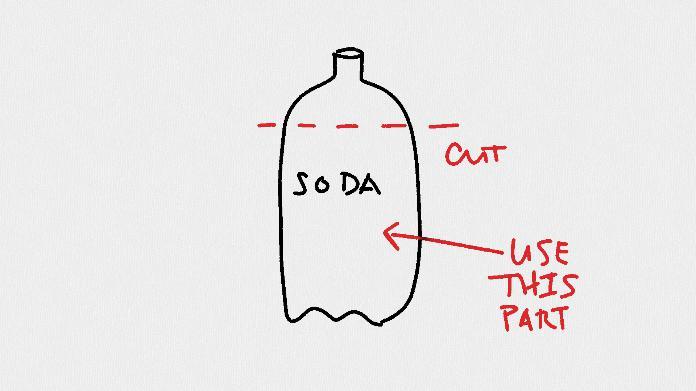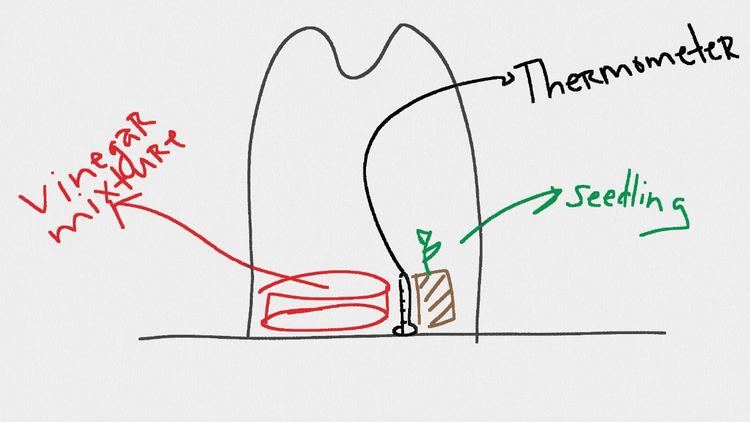| Complexity level: | 7 |
| Time required: | Approximately 1 hour to complete initial set-up, with 15 to 30 minutes daily observation and discussion for five days. |
| Safety concerns: |
Hypothesis
Overview
Plants process carbon dioxide (CO2) into energy using photosynthesis. Humans and other animals expel carbon dioxide when we breathe out. The oxygen we breathe to sustain life largely comes from plants' photosynthesis process, which turns toxic carbon dioxide into breathable air for humans.
Oxygen is not the only product created during photosynthesis. Plants get their energy from carbon dioxide because they convert it into sugar, which they use for food. Plants love to "eat" the sugar, which allows them to grow larger because it gives them energy for growth.
The sun's energy is required for photosynthesis.
Global warming occurs when greenhouse gases such as carbon dioxide absorb extra heat from the atmosphere, raising the ambient temperature. Global warming is thought to be caused by humans' use of fossil fuels, including burning coal and using gasoline in our cars. Water vapor also traps heat in the atmosphere. In this system, we will create a replica of an atmosphere using two-liter bottles. We will examine whether plants grow faster in the carbon dioxide-rich environment or the normal environment.
We will make our own carbon dioxide by combining baking soda and vinegar, which gives off CO2 gas.
Scientific Terms
Materials
- 1 small bag of potting soil
- 2 two-liter soda bottles with the tops cut off
- 4 peat cups with seeds already germinated (just sprouted) in peat cups
- 2 shallow dishes or paper cups cut in half
- 30 g baking soda
- 60 mL white vinegar
- Scale
- Graduated cylinder
- Thermometer
- Ruler

Procedure
- Find a place where your experiment can sit for the week.
- Check the seeds to make sure they have partially sprouted. Set them aside.
-
Make a control experiment by putting one seedling underneath an upside-down soda bottle. Also include a thermometer.

-
Set the control aside. Now, get ready to make the experimental system.
- Measure 15 g of baking soda into the shallow dish or paper cup.
- Measure 30 mL white vinegar in your graduated cylinder.
- Slowly add the vinegar to the cup with the baking soda.
-
Carefully place one peat cup and the cup with the vinegar mixture under the soda bottle. Put the thermometer underneath, as well.

-
Wait 20 minutes, and record your observations in “Day 1” of the observation table below. Do this for both the control and the experimental systems.
-
Make sure to measure the plant’s height with your ruler. Do this on the outside of the bottle, as we do not want to disrupt the system.
-
Record data on your chart every day.
-
On the fifth day, graph both plant’s growth on axes comparing time and height.
Observations
|
EXPERIMENT plant with vinegar mixture |
Day 1 |
Day 2 |
Day 3 |
Day 4 |
Day 5 |
Day 6 |
Day 7 |
|
Can you see water vapor / droplets? Yes or no. |
|||||||
|
Temperature |
|||||||
|
Plant size in cm |
|||||||
|
CONTROL plant without vinegar mixture |
Day 1 |
Day 2 |
Day 3 |
Day 4 |
Day 5 |
Day 6 |
Day 7 |
|
Can you see water vapor / droplets? Yes or no. |
|||||||
|
Temperature |
|||||||
|
Plant size in cm |



Conclusion
Do plants surrounded by more carbon dioxide grow faster or slower?
Do you think the greenhouse effect is helping or hurting plants on earth? What could that mean for crops?
References
Hays, J. "How do increased CO2 levels affect plant growth?"

